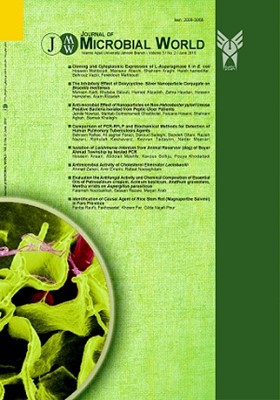The Inhibitory Effect of Doxycycline- Silver Nanoparticle Conjugate on Brucella melitensis
Subject Areas : Medical MicrobiologyMohsen Ajalli 1 , Mojtaba Salouti 2 , Hamed Alizadeh 3 , Zahra Heydari 4 , Hossein Hamzehei 5 , Aram Alizadeh 6
1 - Department of Microbiology, Zanjan Branch, Islamic Azad University, Zanjan, Iran
2 - Biology Research Center, Zanjan Branch, Islamic Azad University, Zanjan, Iran
3 - Young Researcher’s Club, Zanjan Branch, Islamic Azad University, Zanjan, Iran
4 - Department of Microbiology, Zanjan Branch, Islamic Azad University, Zanjan, Iran
5 - Department of Microbiology, Zanjan Branch, Islamic Azad University, Zanjan, Iran
6 - Department of Microbiology, Zanjan Branch, Islamic Azad University, Zanjan, Iran
Keywords: Silver nanoparticles, Antimicrobial effect, Doxycycline, Brucella,
Abstract :
Background and Objective: Brucellosis is a zoonotic disease caused by Brucella bacteria. According to recent studies, antimicrobial activity of silver nanoparticle was approved. The aim of this study was to investigate the antimicrobial activity of Doxycycline - silver nanoparticles conjugate against Brucella meltensis 16M. Material and Methods: After preparing the doxycycline-silver nanoparticle conjugate, its antimicrobial activity against Brucella meltensis 16M was determined by Well Diffusion Agar method in Muller Hintone Agar media. Also, Minimum inhibitory concentration (MIC) and minimum bactericidal concentration (MBC) of Doxycycline-silver nanoparticle conjugate was determined by Macrodilution method in Muller Hintone Broth media. Finally, antibacterial effect of the nanoparticle was assayed in animal model. Results: The results showed that Doxycycline-silver nanoparticle conjugate has antimicrobial activity against Brucella melitensis 16M in laboratory condition. In mouse model, the conjugate of Doxycycline-silver nanoparticle could decrease effectively the Brucella melitensis load in liver. Conclusion: This study demonstrated that Doxycycline-silver nanoparticle conjugate has synergistic effect on Brucella melitensis 16M and can be useful in treatment of brucellosis.
1. Rad MA. Brucellosis, Zoonosis disease. 1st edition. University of Tehran Publication. Tehran. 2009; 94-101. [In persian].
2. Ohishi K, Zenitani R, Bando T, Goto Y, Uchida K, Maruyama T, Yamamoto S, Miyazaki N, Fujise Y. Pathological and serological evidence of Brucella-infection in baleen whales (Mysticeti) in the western North Pacific. Comp Immunol Microbiol Infect Dis. 2003; 26: 125-136.
3. Covert J, Eskra L, Splitter G. Isolation of Brucella abortus total RNA from B. abortus-infected murine RAW macrophages. J Microbiol Methods. 2005; 60(3): 383-393.
4. Fischer NO, Verma, A, Goodman CM, Simard JM, Rotello VM. Reversible "irreversible" inhibition of chymotrypsin using nanoparticle receptors. J Am Chem. 2003; 125(44): 13387-13391.
5. Collee JG, Miles RS. Tests for identification of bacteria. In: Collee JG, Duguid JP, Fraser AG, Marmion BP. Mackie And Mccartney Practical Medical Microbiology, 13Th Ed. Vol. 2, New York: Churchill Livingstone. 1989; 525-530.
6. Mohsen Nezhad F, Zeigham H, Mota A, Sattari M, Yadegar A . Antibacterial activity of Eucalyptus extracts on methicillin resistance Staphylococcus aureus. Res J Biol Sci. 2009; 4(8): 905-908.
7. Ahmad I, Beg AZ. Antimicrobial and phytochemical studies on 45 Indian medicinal plants against multi-drug resistant human pathogens. J Ethnopharmacol. 2001; 74(2): 113-123.
8. Ersoy Y, Sonmez E, Tevfik MR, But AD. Comparison of three different combination therapies in the treatment of human brucellosis. Trop Doct. 2005; 35(4): 210-212.
9. Trujillano -Martin I, Garcia-Sanchez E, Fresnadillo MJ, Garcia-Sanchez JE, Garcia-Rodriguez JA, Montez-Martinez I. In vitro activities of five new antimicrobial agents againts Brucella melitensis. Int J Antimicrob Agents. 1999; 12(2): 185-186.
10. Naeini A, Khosravi A, Tadjbakhsh H, Ghazanfari T, Yaraee R, Shokri H. Evaluation of the immunostimulatory activity of Ziziphora tenuior extracts. Comp Clin Pathol. 2010; 19(5): 459-463.
11. Alizadeh H, 2011, Study of antimicrobial effects of silver nanoparticles on Brucella abortus 544 and Brucella melitensis 16M in in vitro, cell culture and animal model. Faculty of basic and medical science, Islamic Azad University, Zanjan branch. [In persian].
12. Ayala-Nunez NV, Lara HH, Ixtepan-Turrent L, Rodriguez-Padilla C. Silver nanoparticles toxicity and bacterial effect against methicillin-resistant Staphylococcus aureus. J Nanobiotechnol. 2009; 5: 2-9.
13. Cho KH, Park JE, Osaka T, Park SG. The study of antimicrobial activity and preservation effects of nanosilver ingrediant. Electrochimica Acta. 2005; 51(5): 956-960.
14. Kora AJ, Arunachalam J. Assessment of antibacterial activity of silver nanoparticles on Pseudomonas aeruginosa and its mechanism of action. World J Microbiol Biotechnol. 2011; 27(5): 1209-1216.
15. Yussef M, Fattal E, Alonso MJ, Roblot-Treupel L, Sauzieres J, Tancrede C, Omnes A, Couvreur P, Andremont A. Effectiveness of nanoparticle-bound ampicillin in the treatment of Listeria monocytogenes infection in athymic nude mice. Antimicrob Agents Chemother. 1988; 32(8): 1204-1207.
16. Ayala-Nunez NV, Lara HH, Ixtepan-Turrent L, Rodriguez-Padilla C. Bactericidal effect of silver nanoparticles against multidrug-resistant bacteria. World J Microbiol Biotechnol. 2010; 26: 615-621.
17. Li P, Li J, Wu C, Wu Q, Li J. Synergistic antibacterial effects of β-lactam antibiotic combined with silver nanoparticles. J Nanotechnol. 2005; 16(9): 1912-1917.
18. Shahverdi AR, Fakhimi A, Shahverdi HR, Minaian S. Synthesis and effect of silver nanoparticles on the antibacterial activity of different antibiotics against Staphylococcus aureus and Escherichia coli. Nanomedicine. 2007; 3 (2): 168-171.
19. Seleem MN, Munusamy P, Ranjan A, Alqublan H, Pickrell G, Sriranganathan N. Silica-antibiotic hybrid nanoparticles for targeting intracellular pathogens. Antimicrob Agents Chemother. 2009; 53(10): 4270–4274.


